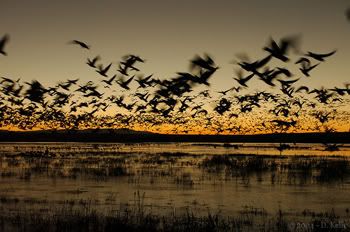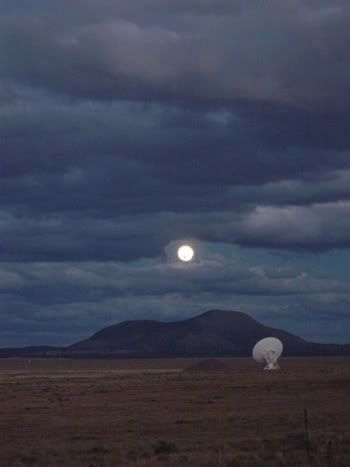
I just watched the movie Contact, starring Jodie Foster. (If you haven't seen the movie, you can find an awesome review here.) Above is one of the movie's most breathtaking scenes, in a movie filled with breathtaking scenes, in which Jodie Foster sits on the edge of a canyon just outside Socorro, New Mexico. This, along with the photographs below, are scenes from Socorro, New Mexico--which is now high on my list of places to visit.

Bosque del Apache National Wildlife Refuge

Radio Telescope at the Very Large Array (VLA)
THE BOSQUE DEL APACHE NATIONAL WILDLIFE REFUGE
Bosque del Apache is Spanish for "woods of the Apache," and is rooted in the time when the Spanish observed Apaches routinely camped in the riverside forest. Since then the name has come to mean one of the most spectacular national wildlife refuges in North America. Here, tens of thousands of birds--including Sandhill Cranes, Arctic Geese, and many kinds of ducks--gather each autumn and stay through the winter. Feeding Snow Geese erupt in explosions of wings when frightened by a stalking coyote, and at dusk, flight after flight of geese and cranes return to roost in the marshes.
The Refuge is located along the Rio Grande River near Socorro, New Mexico, at the northern edge of the Chihuahuan desert.
ABOUT SOCORRO, NEW MEXICO
Socorro is located about 75 miles south of Albuquerque, and is at an average elevation of 4,605 feet. The town lies adjacent to the Rio Grande River in a landscape dominated by the Rio Grande Rift and numerous extinct volcanos. The immediate region encompasses approximately 6,000 feet of vertical relief between the Rio Grande and the Magdalena Mountains. Notable nearby locales include the Cibola National Forest, the BLM Quebradas Scenic Backcountry Byway, and the Bosque del Apache and Sevilleta National Wildlife Refuges.
In June 1598, Juan de Oñate led a group of Spanish settlers through the Jornada del Muerto, an inhospitable patch of desert that ends just south of the present day city of Socorro. As the Spaniards emerged from the desert, Piro Indians of the pueblo of Teypana gave the Spaniards food and water. Therefore, the Spaniards renamed this pueblo Socorro, which means "help" or "aid." Later, the name "Socorro" would be applied to the nearby Piro pueblo of Pilabó.
Nuestra Señora de Socorro , the first Catholic mission in the area, was probably established around 1626. Fray Augustin de Ventancurt would later write that around 600 people lived in the area at this time.
During the Pueblo Revolt of 1680, Spanish refugees stopped in the pueblo of Socorro. A number of Piro Indians followed the Spaniards as they left the province to go south to safety. With no protection of Spanish troops, Socorro was destroyed and the remaining Piro were killed by the Apache and other tribes.
The Spanish did not initially resettle Socorro when they re-conquered New Mexico. Other than El Paso, there were no Spanish settlements south of Sabinal (which is approximately 30 miles north of Socorro) until the 1800s. In 1800, governor Fernando Chacon gave the order to resettle Socorro and other villages in the area. However, Socorro was not resettled until about 1815. In 1817, 70 Belen residents petitioned the Spanish crown for land in Socorro. The 1833 Socorro census lists over 400 residents, with a total of 1,774 people living within the vicinity of the village.
The mission of San Miguel de Socorro was established soon after Socorro was resettled. The church was built on the ruins of the old Nuestra Señora de Socorro.
In the late 1870s and into 1881, noted lawman and gunman Dallas Stoudenmire served as the town Marshal for Socorro.
Today, Socorro is home to the New Mexico Institute of Mining and Technology (New Mexico Tech), a state undergraduate and graduate university specializing in science and engineering. New Mexico Tech hosts a number of major research centers, such as the Energetic Materials Research and Testing Center, the IRIS Consortium Program for Array Seismic Studies of the Continental Lithosphere (PASSCAL) Instrument Center, the New Mexico Bureau of Geology and Mineral Resources, and the Magdalena Ridge Observatory. Also located on the campus is the NRAO (National Radio Astronomy Observatory) Array Operations Center, the headquarters for the Very Large Array and Very Long Baseline Array radiotelescopes. The Very Large Array itself is located west of Socorro, between Magdalena and Datil. The University of Texas at El Paso annually holds their summer football training camp at Tech Field. Tech is also host to the New Mexico Science Olympiad and New Mexico Science and Engineering Fair state competitions.
ZAMORA UFO INCIDENT
Socorro is famous as the site of a well-publicized UFO incident. On April 24, 1964 Lonnie Zamora, a local policeman, was chasing a speeder on Socorro's outskirts when he claimed he saw a bright flash and heard a loud roar coming from over a nearby hill. Believing that the noise may have come from the explosion of a dynamite shack, Zamora drove over the hill. He claimed he saw a metallic, oval-shaped object with a strange symbol on it. He also claimed to see two "small men" in what looked like "white coveralls" walking around outside the craft. When they saw Zamora, the "men" boarded the craft and it took off with a load roar and flame that shook Zamora's patrol car.
Zamora called for help on his radio. Sergeant M.S. Chavez of the New Mexico State Police soon arrived on the scene. Chavez later said that Zamora looked "terrified", that some nearby bushes had been badly burned, and that strange scoop marks were in the ground. Project Blue Book, the US Air Force's official study of the UFO mystery, sent investigators to Socorro. They interviewed Zamora and Chavez, and also checked the supposed landing site. Project Blue Book's supervisor, Captain Hector Quintanilla, later wrote that "there is no doubt that Lonnie Zamora saw an object which left quite an impression on him. There is no question about Zamora's reliability." However, two prominent UFO skeptics both offered various explanations for Zamora's sighting. Dr. Donald Menzel offered two explanations: that Zamora had been the victim of an elaborate prank by local teenagers, or that Zamora had actually seen a dust devil. Philip Klass, the editor of Aviation Week magazine, would claim that Zamora and Socorro's then-mayor had hoaxed the event to bring tourists to Socorro. UFO researchers have disputed each of these explanations.
RADIO ASTRONOMY IN SOCORRO
The Very Large Array (VLA), one of the world's premier astronomical radio observatories, consists of 27 radio antennas in a Y-shaped configuration on the Plains of San Agustin fifty miles west of Socorro, New Mexico. Each antenna is 25 meters (82 feet) in diameter. The data from the antennas is combined electronically to give the resolution of an antenna 36km (22 miles) across, with the sensitivity of a dish 130 meters (422 feet) in diameter.
The Very Long Baseline Array (VLBA) is a system of ten radio-telescope antennas, each with a dish 25 meters (82 feet) in diameter and weighing 240 tons. From Mauna Kea on the Big Island of Hawaii to St. Croix in the U.S. Virgin Islands, the VLBA spans more than 5,000 miles, providing astronomers with the sharpest vision of any telescope on Earth or in space. Dedicated in 1993, the VLBA has an ability to see fine detail equivalent to being able to stand in New York and read a newspaper in Los Angeles.

Thanks for reading.
Technorati Tags:socorro, new mexico, bosque del apache national wildlife refuge, vla, vlba, radio astronomy, contact, jodie foster, rio grande
Generated By Technorati Tag Generator















3 comments:
Matthew S., you've done an excellent piece on this posting. A very interesting read. You're an excellent promoter. Perhaps you'd like to promote Wyoming next. After all, I hear Jackson Hole, Wy. has excellent whitewater rafting sports up there.
My family and I have gone through New Mexico several times in our travels, but I'm ashame to say that we haven't visited any of the places you've noted. I'm also ashame to say that I don't know much about our neighbor state. The only places we've visited in New Mexico are Roswell, Carlsbad Cavern, Living Desert Zoo & Gardens State Park, and the Petrifie Forest. These are all excellent places to visit. And if you haven't been to South Utah, yet, you might like to visit The Arches, Bryce Canyon, Canyonland, Capitol Reef, Monument Valley, and Zion National Parks. Exceptional tourists destinations.
You know what's funny, just earlier today I got told that I needed to watch "Contact" and here, you are, having just blogged about it recently.
I'm gonna have to watch it for sure now. And after I do I may have to make that trip to Socorro. It's kindof odd to have lived in NM for 20 years and never have gone that far south.
Excellent post :)
This is a great post. However, you do have one mistake. Although "Contact" was filmed at VLA, the canyon scene was filmed out of state. There are no canyons (at least canyons that big) near VLA.
The VLA is very impressive. I visited it once a year or two after it was set up, and I've driven by there at least 4 or 5 times since.
Post a Comment